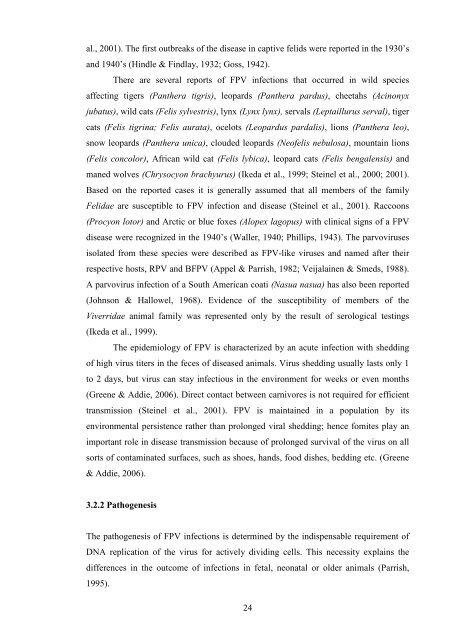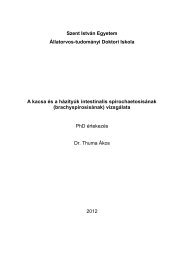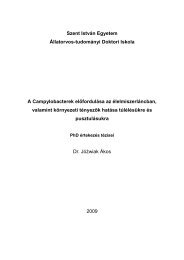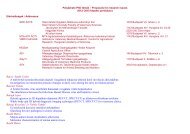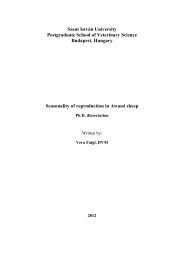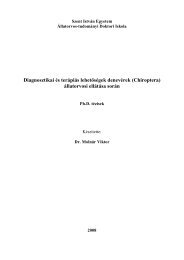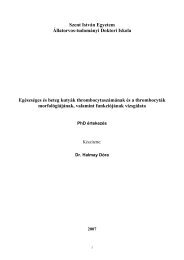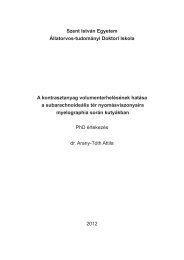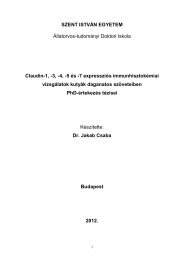PhD Thesis Demeter Zoltan
PhD Thesis Demeter Zoltan
PhD Thesis Demeter Zoltan
You also want an ePaper? Increase the reach of your titles
YUMPU automatically turns print PDFs into web optimized ePapers that Google loves.
al., 2001). The first outbreaks of the disease in captive felids were reported in the 1930’s<br />
and 1940’s (Hindle & Findlay, 1932; Goss, 1942).<br />
There are several reports of FPV infections that occurred in wild species<br />
affecting tigers (Panthera tigris), leopards (Panthera pardus), cheetahs (Acinonyx<br />
jubatus), wild cats (Felis sylvestris), lynx (Lynx lynx), servals (Leptaillurus serval), tiger<br />
cats (Felis tigrina; Felis aurata), ocelots (Leopardus pardalis), lions (Panthera leo),<br />
snow leopards (Panthera unica), clouded leopards (Neofelis nebulosa), mountain lions<br />
(Felis concolor), African wild cat (Felis lybica), leopard cats (Felis bengalensis) and<br />
maned wolves (Chrysocyon brachyurus) (Ikeda et al., 1999; Steinel et al., 2000; 2001).<br />
Based on the reported cases it is generally assumed that all members of the family<br />
Felidae are susceptible to FPV infection and disease (Steinel et al., 2001). Raccoons<br />
(Procyon lotor) and Arctic or blue foxes (Alopex lagopus) with clinical signs of a FPV<br />
disease were recognized in the 1940’s (Waller, 1940; Phillips, 1943). The parvoviruses<br />
isolated from these species were described as FPV-like viruses and named after their<br />
respective hosts, RPV and BFPV (Appel & Parrish, 1982; Veijalainen & Smeds, 1988).<br />
A parvovirus infection of a South American coati (Nasua nasua) has also been reported<br />
(Johnson & Hallowel, 1968). Evidence of the susceptibility of members of the<br />
Viverridae animal family was represented only by the result of serological testings<br />
(Ikeda et al., 1999).<br />
The epidemiology of FPV is characterized by an acute infection with shedding<br />
of high virus titers in the feces of diseased animals. Virus shedding usually lasts only 1<br />
to 2 days, but virus can stay infectious in the environment for weeks or even months<br />
(Greene & Addie, 2006). Direct contact between carnivores is not required for efficient<br />
transmission (Steinel et al., 2001). FPV is maintained in a population by its<br />
environmental persistence rather than prolonged viral shedding; hence fomites play an<br />
important role in disease transmission because of prolonged survival of the virus on all<br />
sorts of contaminated surfaces, such as shoes, hands, food dishes, bedding etc. (Greene<br />
& Addie, 2006).<br />
3.2.2 Pathogenesis<br />
The pathogenesis of FPV infections is determined by the indispensable requirement of<br />
DNA replication of the virus for actively dividing cells. This necessity explains the<br />
differences in the outcome of infections in fetal, neonatal or older animals (Parrish,<br />
1995).<br />
24


